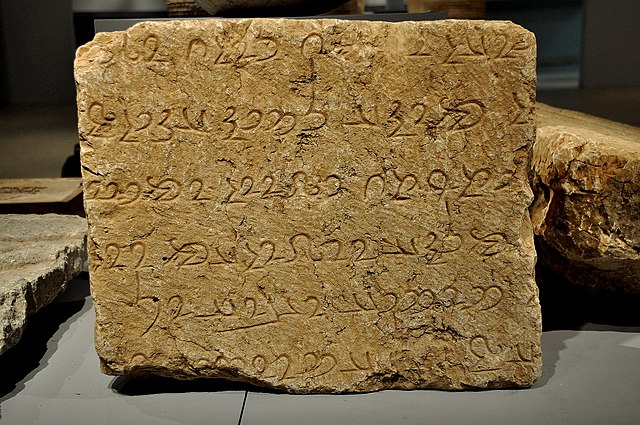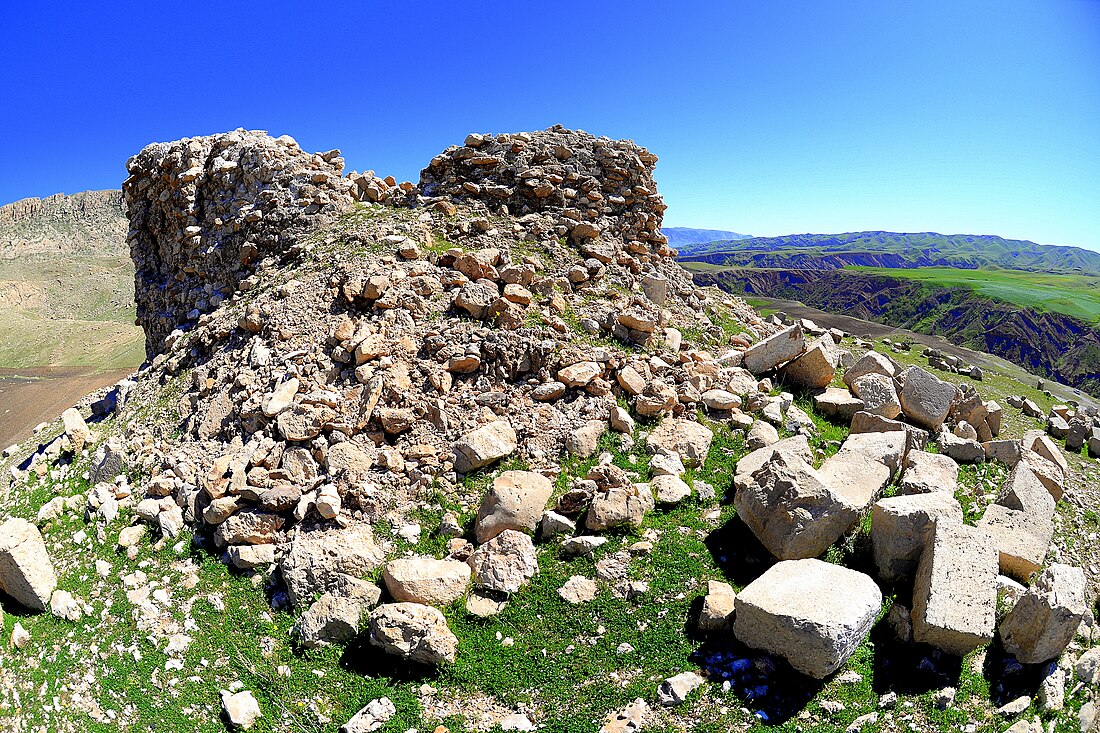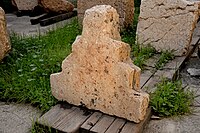Paikuli inscription
Ancient bilingual inscription in Iraqi Kurdistan From Wikipedia, the free encyclopedia
The Paikuli inscription (Kurdish: پەیکوڵی, romanized: Peykulî,[1] Persian: پایکولی, in Arabic: بيكولي) is a bilingual text corpus in Parthian and Middle Persian, inscribed on the stone blocks of the Paikuli Tower's walls. The tower is located in the southern part of Iraqi Kurdistan, near the modern-day village of Barkal in the Sulaymaniyah Governorate, Iraq. These inscribed stone blocks are now housed in the Sulaymaniyah Museum, with the field only containing the stones used in the tower’s construction.[2] The inscription was erected as a monument to victory and explains how and why the Sasanian emperor Narseh (also written as Narses) ousted his grandnephew from power.[3]
 Paikuli Tower | |
 | |
| 35°5′53.91″N 45°35′25.95″E | |
| Location | Sulaymaniyah Governorate, Iraq |
|---|---|
| Designer | Narseh |
| Type | Tower |
| Material | Stone |
| Beginning date | 3rd century AD |
In 293 Narses marched from Armenia in open revolt against his nephew with a host of supporters and allies, whose names are recorded on the Paikuli inscription.[4]
Background
The Paikuli inscription of Narses shows that Asuristan (Babylonia) at least was in Persian hands, but says nothing of Nisibis and Singara.[5]

The fact of Amr ibn Adi's vassalage to Narses was preserved by the latter in the Paikuli inscription.[6]
Paikuli inscription may be devoid of much historical information because it belongs to the genre of epic literature composed since time immemorial in the ancient Near East.[7]
In the 19th century, when it was visited by several travelers, it consisted of the ruins of a large, square tower that had originally been covered on all sides by stone blocks, some contained inscriptions, but, at the time, lay scattered all around the monument.
Sassanians
In Tabari and sources that follow his work, and also in the Paikuli inscription of Narses, a son of Papak called Shapur is mentioned as his successor, although the text of the inscription of Paikuli in which king Shapur appears is unclear because of long lacunae. Some suggest that Narses in the inscription sought to compare his succession to the throne with that of his grandfather Ardashir, just as Ardashir had succeeded Shapur.
S. Mori contends that the Paikuli inscription is basically relating the traditional Near Eastern story of how a king achieves supremacy with the aid of the gods in the epic form. He also believes that the early Islamic texts, such as al-Tabarī are of little use for the history of the Sasanian period.[8]
Gallery
Summarize
Perspective
The Sulaymaniyah Museum in Iraqi Kurdistan opened a new Gallery on June 10, 2019, dedicated to the Paikuli Tower, its inscription, and King Narseh. The Sulaymaniyah Museum is the only Museum which displays relics of the Paikuli Tower.[9]
- Recently discovered C2 inscribed stone block, Middle Persian script, from the Sassanian Paikuli Tower, Sulaymaniyah Museum
- Recently discovered c12 inscribed stone block, Parthian script, from the Sassanian Paikuli Tower, Sulaymaniyah Museum
- A2 inscribed stone block, Middle Persian script, from the Sassanian Paikuli Tower, Sulaymaniyah Museum
- d3 inscribed stone block, Parthian script, from the Sassanian Paikuli Tower, Sulaymaniyah Museum
- One of the inscribed stone blocks from the Paikuli Tower of Narseh. Late 3rd century AD. Sulaymaniyah Museum
- f7 block from the Paikuli Tower inscribed with Parthian language. Sassanian, reign of Narseh, late 3rd century AD. From Sulaymaniyah, Iraq. Sulaymaniyah Museum
- Newly discovered f1, Parthian inscription, block from the Paikuli Tower of Narseh, Sulaymaniayh Museum
- One of the non-inscribed rounded stone blocks from the Paikuli Tower of Narseh. Sulaymaniyah Museum
- Newly discovered fragment of stone block G6, Middle Persian script, Sassanian Paikuli Tower, Sulaymaniyah Museum
- One of the busts of the Sassanian king Narseh. Late 3rd century AD. From the Paikuli Tower, Sulaymaniyah, Iraq. Sulaymaniyah Museum
- Recently discovered fragment of a braid of hair of Narseh's bust, from the Sassanian Paikuli Tower, Sulaymaniyah Museum
- Part of Narseh headdress from the Sassanian Paikuli Tower, Iraq
- Non-inscribed stone blocks scattered around the Paikuli Tower of Narseh. Sulaymaniyah Governorate, Sulaymaniyah Museum
- One of the non-inscribed rounded stone blocks from the Paikuli Tower of the Sassanian king Narseh. Sulaymaniyah Museum
- Non-inscribed building stone of the Sassanian Paikuli Tower of Narseh, Sulaymaniyah Museum
- Bust of the Sassanian king Narseh, Sulaymaniyah Directorate of Antiquities
References
Further reading
External links
Wikiwand - on
Seamless Wikipedia browsing. On steroids.
















